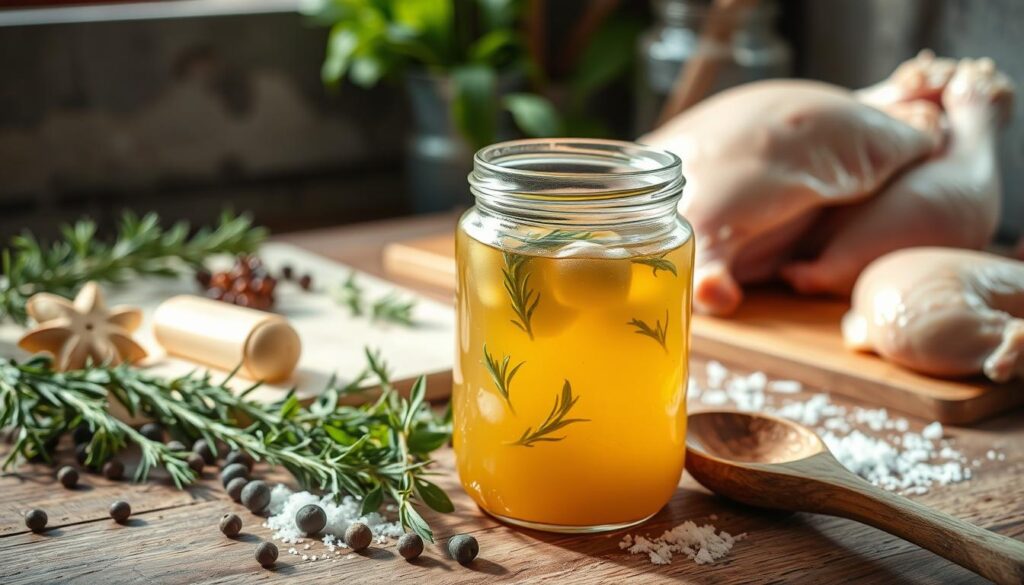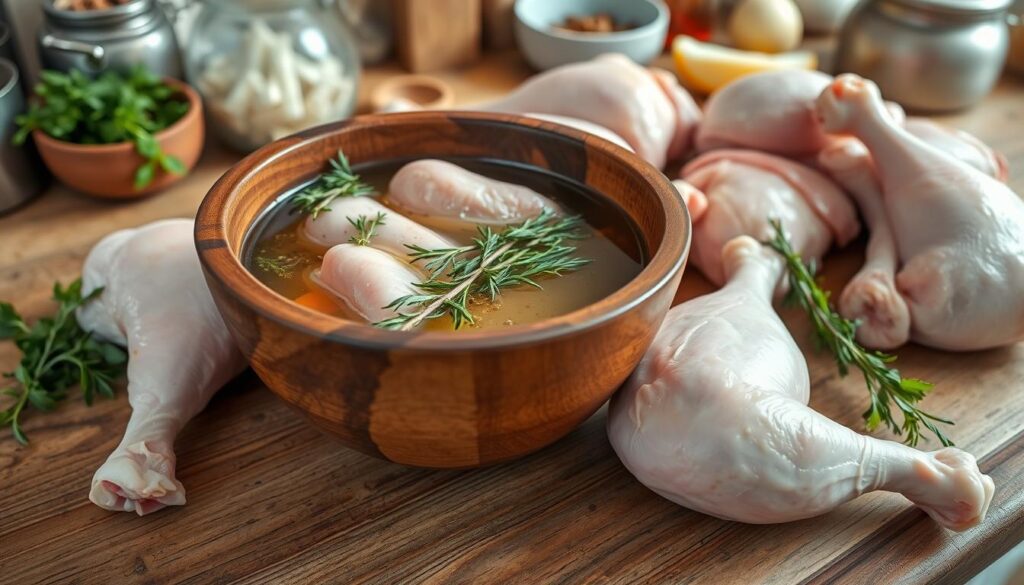What Is Brining Chicken?
Brining Chicken as a home cook, I’ve always been fascinated by brining. It’s a technique that’s often seen as elite, but it’s easy to do at home. Brining makes chicken juicy and flavorful. It tenderizes the meat and keeps it moist.
Brining is about soaking chicken in a salt–water solution before cooking. It does three main things: it keeps the meat moist, changes its texture, and seasons it inside out. This makes the chicken tender, juicy, and full of flavor.
Table of Contents
Key Takeaways
- Brining is a technique that involves soaking meat, particularly chicken, in a salt–water solution before cooking.
- This process enhances the moisture, tenderness, and flavor of the chicken.
- The brine solution typically consists of water, salt, and optional seasonings like herbs and spices.
- Brining alters the meat in three ways: increasing moisture retention, changing the texture through protein denaturation, and seasoning the meat from the inside out.
- The result is juicier, more tender, and more flavorful chicken.
Understanding the Basics of Chicken Brining
Brining is a key technique that makes chicken taste better and stay moist. It works by letting flavor enhancement, moist meat, and sodium chloride brine get into the chicken’s cells. This makes the chicken juicier and more tender.
The Science Behind Brining Chicken
When chicken is soaked in saltwater, the salt pulls moisture from around it. This makes the meat absorb the sodium chloride brine. It also keeps the moist meat from drying out while cooking.
Types of Brining Chicken Methods
- Wet Brining: This method soaks the chicken in saltwater. It lets the sodium chloride brine get into the meat for better flavor enhancement and moist meat.
- Dry Brining: Here, you rub a dry salt mixture on the chicken. It then dissolves and spreads into the meat, like wet brining.
Benefits of Brining Chicken Poultry
Brining has many benefits for chicken, including:
- More Moisture: The sodium chloride brine helps the chicken stay moist while cooking. This makes it juicier and more moist meat.
- Tender Meat: Brining breaks down the chicken’s muscle fibers. This makes the meat tender and more flavor enhancement.
- Even Flavor: The sodium chloride brine lets seasonings get deep into the meat. This ensures every bite is full of flavor.
Both wet and dry brining can make your chicken dishes juicier and more flavorful.
Essential Components of a Brine Solution
The key to a great brine is water and salt. You need 4 cups of cold water and 6 tablespoons of Diamond Crystal kosher salt. Or, you can use 4 and a half tablespoons of Morton’s kosher salt, or 3 tablespoons of fine/table salt. The right salt-to-water ratio is important for brining to work well.
You can also add garlic powder, herbs, and spices to your brine. These extras can make your brined chicken taste even better. They add a personal touch to your dish.
- Water: The base of the brine solution, providing the medium for salt and other ingredients to dissolve.
- Salt: The primary ingredient that aids in the brining process. Different types of salt, such as kosher or table salt, have varying effects on the brine.
- Optional Ingredients: Herbs, spices, and other seasonings can be added to the brine to create unique flavor profiles.
Remember, the salt-to-water ratio is crucial for effective brining. Try different salts and adjust the amounts to find your favorite brine. This will depend on the chicken you’re using.
“Brining is a simple yet transformative technique that can elevate the flavor and texture of your chicken dishes.”
The Role of Salt in Brining Chicken Process
Salt is at the core of brining. It helps keep meat moist and adds flavor. The type of salt and how much you use are key to success.
Different Types of Salt for Brining
Not all salts are the same for brining. Kosher salt is popular because it dissolves well and keeps salt levels even. Table salt, with its finer grains, can make the brine too salty.
Sea salt adds a unique flavor but its saltiness can vary. It’s important to get the salt-to-water ratio right to avoid too much salt.
Salt-to-Water Ratios
- For a standard brine, use 4 1/2 tablespoons of Morton’s kosher salt or 3 tablespoons of fine table salt per 4 cups of water.
- Dry brining, a salt-only method, typically calls for 1-1/2 teaspoons of kosher salt per pound of meat.
- The strength of the brine solution is critical, with the FDA recommending a 10% solution for food processing, which equates to 6 tablespoons of salt per quart of liquid.
Getting the salt concentration right is crucial. Try different ratios to find what works best for you.
“Brining improves the juiciness and moisture content of pork, poultry, and shellfish, making them more flavorful and tender.”
How to Make the Perfect Brine Solution
Making the perfect brine solution is key to juicy, flavorful chicken. It’s simple but requires a few steps. Let’s explore how to make the best brine for your chicken.
Start with cold tap water as your brine base. This keeps it cool and helps salt dissolve well. Choose kosher salt for its easy-dissolving crystals, unlike table salt.
- For a standard brine, aim for a ratio of 1/2 cup of kosher salt per 2 quarts of cold water.
- If you prefer a more flavorful brine, you can also add 1/4 cup of brown sugar to the mixture.
- For an extra punch of flavor, consider incorporating 1 teaspoon of garlic powder or other dried herbs and spices.
Stir until the salt is fully dissolved, which might take a few minutes. Don’t boil the brine, as it’s not needed and can slow down the process.
For an even more flavorful brine, blend fresh herbs, garlic, and other aromatics with the water and salt in a food processor. Then add the rest of the water. This method creates a richer flavor that will enhance your chicken.
| Ingredient | Quantity |
|---|---|
| Cold water | 2 quarts |
| Kosher salt | 1/2 cup |
| Brown sugar | 1/4 cup |
| Garlic powder | 1 teaspoon |
| Dried herbs (optional) | 3 tablespoons |
By following these steps, you’ll make a perfect brine solution. It will turn your chicken into a juicy, flavorful dish.

Brined Chicken: Step-by-Step Process
Brining is a popular method for cooking chicken. It makes the meat juicier and more flavorful. If you’re new to brining, here’s how to do it right.
Preparation Steps
- First, get a large container or a resealable bag, water, salt, and any extra seasonings or herbs you like.
- Make the brine by mixing salt into water. Use a 5-8% salt solution. You can also add herbs and spices for extra flavor.
- Put the chicken in the brine, making sure it’s fully covered. Then, refrigerate it for the right amount of time. This depends on the chicken cut.
Brining Techniques
The brining time varies. Chicken breasts need 15-30 minutes, while a whole bird takes 4-6 hours. The size and thickness of the chicken affect the brining time. Check the best times for different cuts to get the best results.
Post-Brining Handling
Once brining is done, take the chicken out and dry it with paper towels. Don’t rinse it, as this can remove the brine’s benefits. You can cook it right away or store it in the fridge for up to three days. Remember, the chicken is already seasoned, so don’t add extra salt when cooking.
| Chicken Cut | Brining Time | Moisture Retention | Cooking Time Reduction |
|---|---|---|---|
| Chicken Breasts | 15-30 minutes | 30-40% | 15-20% |
| Whole Chicken | 4-6 hours | 35-45% | 18-22% |
By following these steps, you can make deliciously brined chicken. It’s juicy, flavorful, and a treat for your taste buds. Try different brine recipes and times to find what you like best.
Optimal Brining Times for Different Cuts
Brining your chicken is key to juicy, flavorful meat. But, how long you brine matters a lot. Knowing the right brining times for each chicken cut is important for the best taste and texture.
For chicken breasts, brine for 30-60 minutes. This short time lets the salt and seasonings soak in without making it too salty. Whole chickens need a longer brine of 4-6 hours. This ensures the whole bird is seasoned well, making it moist and tasty.
| Chicken Cut | Optimal Brining Time |
|---|---|
| Chicken Breasts | 30-60 minutes |
| Whole Chicken | 4-6 hours |
Brining too long can make meat too salty and spongy. Always chill the chicken in the fridge if brining for over 30 minutes. The goal is to get the perfect balance of flavor and texture for your chicken.

“Brining is a game-changer for chicken. It transforms even the driest cuts into juicy, flavorful masterpieces.”
Flavor Enhancement Options
Boosting the taste of your brined chicken is easy and effective. Adding herbs, spices, and seasonings to your brine can make a big difference. It turns your meal into a feast for your taste buds.
Herbs and Spices
Herbs and spices are key for adding flavor to your brine. Popular choices include:
- Garlic powder
- Fresh or dried rosemary
- Thyme
- Peppercorns
- Bay leaves
- Smoked paprika
- Onion powder
To get the most flavor, mix these ingredients with water and salt before adding them to the brine. This way, the flavors blend well, making your brine more aromatic and tasty.
Additional Seasonings
You can also add more seasonings to your brined chicken. Some great options are:
- Citrus zest (lemon, orange, or lime)
- Brown sugar or honey for sweetness
- Minced garlic or shallots for a savory taste
- Chili peppers or crushed red pepper flakes for spice
There are countless ways to customize your brine. Try different mixes to find the perfect flavor for you. It should match your cooking style and taste preferences.
“Brining is all about unlocking the natural flavors of the meat. With the right blend of herbs, spices, and seasonings, you can create a truly remarkable dining experience.”
Common Brining Mistakes to Avoid
Brining can make chicken juicy and flavorful. But, there are common mistakes to watch out for. One big mistake is oversalting the brine, making the chicken too salty. Be careful with the salt-to-water ratio and remember, a little salt is enough.
Food safety is key when brining. Don’t let chicken sit in brine too long, especially at room temperature. This can lead to bacterial growth. Always brine in the fridge and keep it under 24 hours.
Another mistake is not drying the chicken well after brining. Rinsing can remove the brine’s benefits and spread bacteria. Instead, dry the chicken with paper towels before cooking. When cooking brined chicken, be careful of the saltiness. Adjust your seasoning and use low-sodium stock for gravy to avoid a salty sauce.

